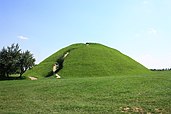Portal:Poland/Selected article/14
The main event that took place within the lands of Poland in the Early Middle Ages was the arrival and permanent settlement of the Slavic peoples. The Slavic migrations in the area of contemporary Poland started in the second half of the 5th century CE, some half century after these territories were vacated by Germanic tribes, their previous inhabitants. The Slavs lived from cultivation of crops, but also engaged in hunting and gathering. They formed small tribal organizations, some of which coalesced later into larger, state-like ones. Beginning in the 7th century, these tribal units built fortified structures with earth and wood walls and embankments, called gords. By the 9th century, the Slavs had settled the Baltic coast in Pomerania, which subsequently developed into a commercial and military power trading with the Old Prussians and the Vikings. During the same time, the tribe of the Vistulans, based in Kraków and the surrounding region, controlled a large area in the south. But it was the Polans who turned out to be of decisive historic importance. They went through a period of accelerated building of fortified settlements and territorial expansion beginning in the first half of the 10th century. Under Mieszko I, the expanded Polan territory was converted to Latin Christianity in 966, which is commonly regarded the birth of the Polish state. (Full article...)

